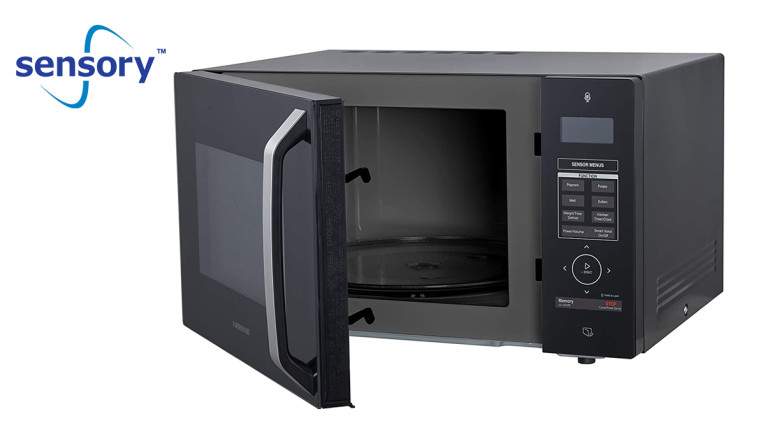
The Silicon Valley AI developer teamed up with Farberware to introduce the first truly smart voice AI-enabled microwave oven, that doesn’t need to rely on an Alexa smart speaker being nearby. The Linux-based Farberware microwave with integrated, edge-based voice assistant is smart on its own and requires no complicated setup, no Wi-Fi connectivity and most importantly, doesn’t report what users say back to any servers.
Sensory’s custom voice assistants deliver total user privacy and are ready to power many home devices requiring a private and reliable voice UI. With this effort, Sensory believes it will contribute to helping custom voice assistants go mainstream, powering everyday appliances and changing how people interact with things.
The new Farberware FM11VABK voice-controlled microwave oven, now available in the US market, relies on Sensory’s TrulyHandsfree and TrulyNatural technologies to provide all the benefits of a custom voice assistant without the privacy compromises of cloud-based, general-purpose assistant platforms.
Conceptually, custom voice assistants are voice assistants trained for specific domains, making them capable of outperforming general-purpose assistants like Google, Alexa, and Siri in quality of experience. Amazon has already jumped on this trend with its announcement of custom voice assistants. Sensory has led the market in this same direction, but with a few substantial differences.
Sensory does it 100% on device, keeping voice data completely private, with no data collection from the product and no recordings sent to the cloud. This also means no added costs for cloud connections.
Due to the edge architecture of Sensory’s domain-specific assistant technology, manufacturers can enjoy hassle-free setup - no Wi-Fi, no apps, no third-party hardware, and no cloud-connected assistant always listening in. Users can just plug the microwave into a power outlet and it is ready to understand numerous voice commands, such as, “Open door,” “cook popcorn,” “set timer to one minute 36 seconds,” “defrost,” “reheat for 2 minutes,” and many more commands.

“We’re at a turning point with voice UI technology. People love the convenience of mainstream voice assistants, but privacy, accuracy, complicated setup, and connectivity issues continue to be a growing concern among users. These concerns have intensified the need for custom private voice assistants,” says Todd Mozer, CEO at Sensory. “Sensory’s customer base used to be driven by companies like Amazon, Google, Microsoft, and Samsung that licensed Sensory technology to improve their general assistant offerings. Today we’re seeing a major shift, with most of our customers being brands that want to own and manage their own private custom voice assistant platforms.”
The Farberware microwave is an example of what can be done at the edge. The large-vocabulary recognizer with a custom statistical language model and NLU can support complex actions like, “Cook four baked potatoes.” Because the Sensory NLU engine looks for “intents'' within a limited domain, the chance of being misunderstood is substantially less than any off-the-shelf assistants. Sensory’s product testing division, Vocalize.ai evaluated the device for speech recognition accuracy and task completion rate, and when benchmarked against the Amazon Basics Microwave with Alexa, the Farberware microwave accurately recognized and executed 68% more spoken commands than Alexa. The complete evaluation report is available from Sensory.
“Smart appliance adoption is growing among US broadband households. Thirteen percent of US broadband households now own a smart appliance and smart microwaves are a leading category. Voice control is a highly-valued feature for smart appliance owners, with more than one-fifth of those who own or intend to purchase various smart appliances rating voice control as one of the most appealing features of the appliance,” said Patrice Samuels, senior analyst, Parks Associates.
A demo video of Sensory’s technology powering a microwave can be found here.
For more details on the Linux-based Farberware FM11VABK microwave development visit our sister publication's website Linux Gizmos.
This news expands on Sensory’s recent announcement of its VoiceHub platform, a free-to-use set of web tools that give brands the power to quickly create custom wake words and powerful, private voice assistants supporting many languages in just a few minutes.
www.sensory.com







